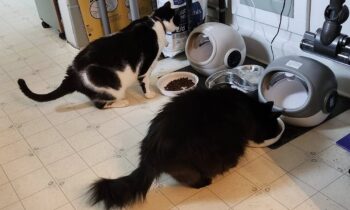
Foods
I was shocked to find out earlier this year that my next-door-neighbors’ dog had been very ill. Their veterinarian determined that Libby’s extremely serious digestive disorder had been caused by a brand-name dog food which, it turns out, was poisoning dogs. Libby recovered, much to the relief of her loving family . . . who, needless to say, felt terrible about what had happened. So did I.
I had known about the problems with this particular dog food for a long time—something that’s probably true of most trainers, animal care workers, and veterinarians. Libby’s family, like so many folks with pets, had not heard the news, had not read the rumors. They thought they were feeding a food that would be good for their canine companion. Instead, it might have killed her.
Here’s a suggestion: Google the name of your dog’s food and see what you come up with! Search for “dog food recalls” or “dog treat recalls” and you will get even more information. And it’s not just one company that appears to be endangering the health of our pets: it’s many. Sometimes recalls can be for manufacturing errors (wires in the kibble, for example), and sometimes food is recalled as a result of contamination (salmonella is common). Sometimes, foods that should be recalled aren’t . . . because, it appears, the companies are unwilling to admit their product is harmful in any way.
Your job as a responsible pet owner is to keep up with the recalls. Keep up even with the rumors! Each dog food “scandal” starts with just a few reports. It takes a long time for the snowball effect to kick in, but when it does, you should be on top of it. Your veterinarian, your groomer, your training class instructor, and your friends with dogs can help. Ask questions, do your research, get answers. When uncertain, find a food you have no doubts about. Your pet’s life may depend on it!

Xylitol
Xylitol is a naturally occurring substance. It is a sugar alcohol, commercially extracted from corn fiber, birch and hardwood trees, and vegetable material. It’s been used as a sugar substitute for years. It has recently become extremely popular for use in oral care products and pharmaceuticals, and as an additive to foods. Products that can contain xylitol include sugar-free gum, candy, breath mints, cough syrup, chewable vitamins, mouthwash, toothpaste, and baked goods.
Xylitol is extremely toxic to dogs. Small amounts of xylitol can cause hypoglycemia (low blood sugar), seizures, liver failure, even death in dogs. Xylitol is estimated to be 100 times as toxic as chocolate to dogs! The most common incidences of xylitol poisoning come from dogs ingesting sugar-free gum, but since xylitol is now being used in many brands of peanut butter, owners may inadvertently be feeding their dogs treats made with this extremely dangerous ingredient. For your dog’s safety, check all labels!
Toys
The online dog community has been horrified in recent days to discover a whole new dangerous dog-toy scenario, one that we haven’t seen before—a dog who got his tongue stuck in the hole of a toy part shaped like a ball. Again, I’m not naming names; Google it. The photos are frightening. The dog was able to get his entire tongue stuck inside the toy, but could not pull his tongue loose. Overnight, with the blood supply to the tongue affected, the situation became very serious. When they found their dog the next morning, his owners rushed him to their veterinarian. The dog’s tongue was so damaged, it had to be removed. The owners opted to euthanize the dog.
Another toy, about the size of a tennis ball and meant for throwing, has inside it a small plug a little bigger than a quarter. The plug is certainly small enough for a dog to swallow. One dog, who is not a toy eater, liked to hold this toy in his mouth and squeeze it gently in his teeth. When the dog stopped eating and became very ill, the owner’s vet encouraged exploratory surgery. The vet ended up removing the plug from the toy from the dog’s small intestine. Surgery is expensive and can be very hard on a dog. Without surgery, though, there is a good chance the dog would have died.
Hollow rubber balls (with or without plugs) that have only one hole can relatively easily get stuck on a dog’s tongue. To avoid any possible accidents or injuries, do not give your dog hollow balls with only one hole. Instead, opt for toys that have two holes (or more!) to keep your dog safe!
Leashes
Flexible leads—we’ve talked about this subject before! There is not a single flexible lead available that does not pose enormous dangers for both the human who uses it and the dog upon whom it is used. Flexible leads used to seem like such a great idea, I know. I own several myself and have used them with my own dogs, but I stopped years ago. Why? Flexible leads can injure dogs, and they can injure people. Want to see the gory photos? Google “flexible dog leash injuries.” I have discussed flexible leads with many friends who use them and have come to the conclusion that normally reasonable people may not accept my warnings as a serious concern . . . because, as yet, they have had no problems. And, as they always tell me, “It’s just so convenient!”
You have been warned. You may insist that you’ll be just fine with your flexible leash, you’ll be really careful, you know nothing bad will happen to you or to your dog. I hope you’re right.
But make that decision after you’ve Googled the subject (not just the gory photos) and read all the articles. Do not count on accurate information from anyone who’s selling flexible leashes! I suggest you stick with information offered by veterinarians, trainers, and average dog owners who’ve had disasters with their own dogs on flexible leads. Should you decide to keep using your flexible lead, read up also on how to use it effectively and safely (at least, as safely as possible). Please!



